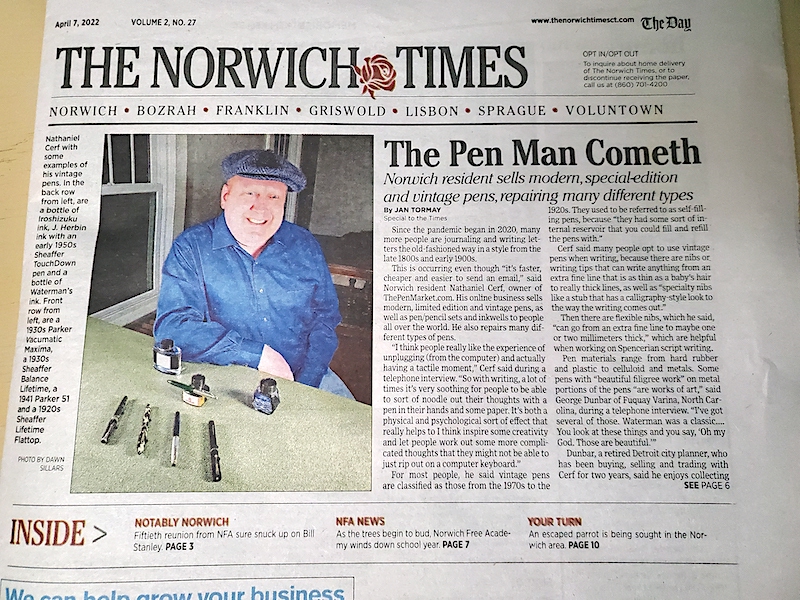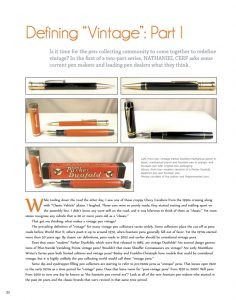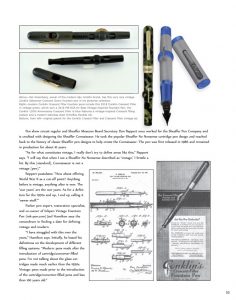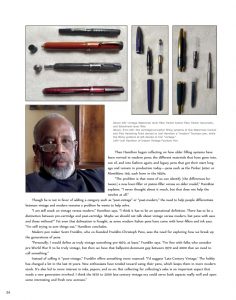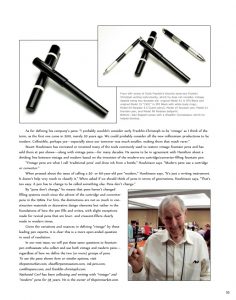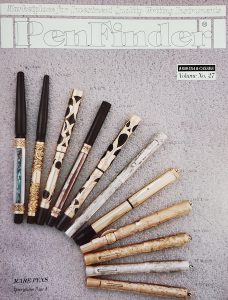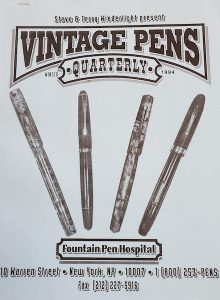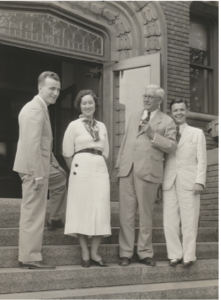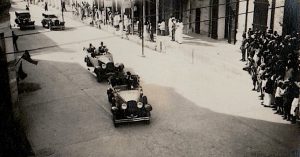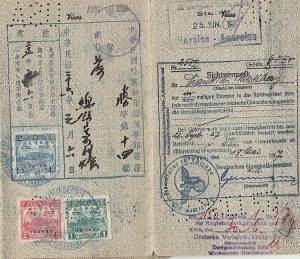News about ThePenMarket.com is spreading. I was lucky enough to be honored by a front-page feature in The Norwich Times! We’ve been featured before in “Pen World” magazine. However, I think this is our first time in a newspaper. Check it out: https://www.theday.com/local-news/20220406/norwich-resident-specializes-in-modern-vintage-pens

Tag Archives: vintage pens
Pen World: Defining Vintage Part 1
Just what is it that makes a pen vintage? Many people are asking that question these days. As time advances, are the old definitions of “vintage” and “modern” really holding up? My article in Pen World Magazine is the first of a two part series. In Part 1, I put the question to 4 legendary experts who helped to build the pen collecting hobby into what it is today. In part 2, I will put the same questions to a new generation of collectors and users. Yet, for now, here is Part 1, reprinted here with permission from Nicky Pessaroff, editor of Pen World Magazine.
To better read each page, click the individual images.
Pen Collecting Time Capsule
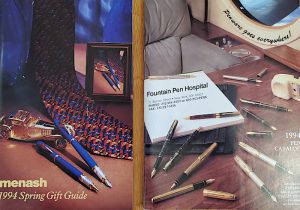
Here are two 5″ X 7″ pen catalogs from 1994! I was intrigued by the Menash catalog as I don’t know what became of that company.
Leaving the pen-collecting life behind, a friend of mine has given me his stash of catalogs and advertising from 1992 through 1994. Its contents blew my mind.
Most of the material was from 1994, the spring I graduated high school. While it is difficult for me to comprehend that was 27 years ago, what is harder to comprehend was how big pen collecting was becoming that long ago!
I found my first fountain pen in 1985 when I was 9 and adored it. It belonged to my late grandfather, and it still worked: a 1928 Sheaffer Lifetime Balance. I used it until it finally broke down, and I became obsessed with finding other fountain pens. They just didn’t exist. Not in my 10-year-old world or the various circles I moved in. I asked adults for them, and all the adults laughed and said they threw their fountain pens out years ago because ballpoints were “so much better.” Even then, I knew that was heresy.
Sheaffer sent me an Imperial to replace my grandfather’s pen, which they could no longer fix. I snatched up those terrible Sheaffer Student Pens at the grocery store. Yet, I was the only person of any age I knew who loved fountain pens. Studying German while in a San Diego high school, my teacher told us that most German kids and adults still preferred using fountain pens. San Diego had no pen stores that I knew of, and the internet did not exist. I worked a part-time job and saved most of my money to pay for my trip as an exchange student to Germany. Most of my fellow American exchange students saved up their money so they could drink heavily in a nation where the drinking age was 16. I begged my German family to be taken to a proper stationary shop. I gleefully purchased a stub-nibbed elegant black Rotring and a bottle of Pelikan royal blue ink. I wrote with that poor beast until its threads wore off. It wasn’t until the internet got more advanced that I could search for fountain pens and finally start finding them in about 2005.
And sooo, it surprises me now to see that while I was searching the world over for fountain pens, there was a ground swell of people who did still love fountain pens…and vintage pens, at that! Plus, many of the people I know on the pen show circuit were innovators of the vintage pen revival.
For example, when I first met Glen Bowen, I did not know he founded “Pen World” magazine. He had already sold his stake in it, but his wife Susan was still the circulation director at Pen World. She and I bonded over the fact she went to journalism school at Northwestern with my father. When she later introduced me to Glen, I thought he was just a pen newbie helping his wife at the Pen World table. Ooops!
In this stack of publications is a protean “Pen World” magazine catalog he published in 1992 called the “Pen Finder.” It was printed at the same time as the early “Pen Worlds” but was a catalog of vintage pens he restored that collectors could buy. You had to subscribe to it. There were simply several glossy photos of capped fountain pens and some inner pages that served as an index of what the pens were and how much they cost. No nib photos. As people didn’t yet know the history of the pens as well then as they do now, I think I even spotted a few pens with mismatched caps and barrels.
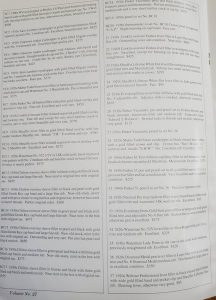
The catalog index of pens for sale in “Pen Finder.” Back then it was too expensive to print color on every page of a magazine. As such there would be color pages and B&W pages.
Without the internet, vintage pen research was a slow and ongoing process. So many of those early collectors had to do their own research into the histories of pens. And much of that was very hit and miss. The internet really made it easier for everyone to get together and compare notes and research.
I love the low-tech feel of these publications. The world-famous Fountain Pen Hospital vintage pen catalog was just a photo-copier copy of pens and prices. Bexley Pens advertised new models with a beautiful glossy photo paired with a home-printer list of features and benefits.
The more professional catalogs for new merchandise were more sophisticated, but I sure as hell wish I could get my hands on some of this Montblanc and Omas at their original pricing. Brand-new, factory-fresh Montblanc 164 Classique models for $99. Omas fountain pens for $325 to $100! FPH was selling a stash of 14k gold #5 Waterman MUSIC NIBS for $50 a piece!
Vintage pen prices were all over the map. There were rare pens for $100 or $200. Really common pens for up to $800. And, yet, other pen prices haven’t changed. Standard Parker Vacumatics went for around $125.
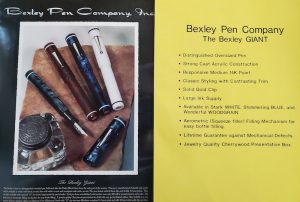
Ads for the Bexley Giant. Note the glossy one-page sheet paired with a home-printer fact sheet. That was not unusual advertising back then. It was fairly slick and affordable.
When I finally got some guidance from my buddy Hans who taught me about vintage pens and how to repair them in 2005, I felt like we were the last two people on earth who loved old fountain pens. With his instructions, I felt as if I was somehow reinventing the wheel or reviving a long dead religion. Yet, this is evidence I was never truly alone back then. I was just searching in all the wrong ways and places.
It is easy to be glib and say, “Oh, gee, I wish I knew in 1994 what I know now.” While that wouldn’t be untrue, I really wish I knew my pen tribe then and could take the journey with them to where we are today. Fountain pens have always brought me joy, and they clearly bring many other people joy. And while I am very happy we have found each other in this grand and glorious age of the internet, it would have been nice to have learned and shared at an even earlier age.
Decameron 2020: Four Guys Walk into a Bar
Four Guys Walk into a Bar
by Art Cerf
A priest, a rabbi, a TV evangelist and an agnostic walk into a bar.
Sounds like the beginning of a great joke but in truth, it’s the beginning of a story.
The four were fast friends back in college some 35 years ago and once a year in the fall, they’d meet on campus to update each other, tell old stories, drink, play cards, curse and spit. They all agreed to get a Covid test before this year’s gathering and three of the four did so. The fourth meant to but got busy and forgot. But he was feeling great and had been nowhere near anyone with the virus.
The tele-evangelist was the last to arrive and saw his friends at a table down at Morrie’s…their agreed upon rendezvous. After handshakes and hugs, they called the barmaid over. The evangelist– a millionaire many times over–ordered the most expensive bourdon in the house and a double at that. The priest ordered a white wine. The rabbi–a recovering alcoholic–stayed with a diet Coke and the agnostic had a beer.
After much laughter, a second round was ordered and after those drinks were finished, the TV preacher dropped a hundred dollar bill on the table and told the waitress to keep the change.
They then walked over to the best hotel in town where the evangelist had booked a suite big enough for the four of them. The agnostic said even if they split the cost four ways, he couldn’t afford it. The rabbi and the priest agreed but the preacher waved them off and said he’d pick up the tab and write it off on his taxes.
They went upstairs and soon were playing the game of Hell at ten cents a point like they had 35 years earlier, youthening as they played.
Hours later, everyone was hungry so the preacher called down to room service. He ordered a large Porterhouse steak for himself. The priest just wanted a bowl of soup. The rabbi said he’d have a Rueben and the agnostic said that sounded good to him and added a side of cole slaw. Then the TV preacher added a bottle of champagne.
The young waiter wheeled in the feast and the preacher opened the champagne with a pop and poured for everyone, including the young waiter. He thanked the group but said he wasn’t allowed to drink on the job. The minister said rubbish, tucked a $50 in his pocket and said, “Drink up.”
The young man removed his mask, took two sips, thanked everyone and left.
The weekend was fun for all and as they left their separate ways, the preacher thought though he loved them all, he was surprised on how depressingly ordinary their lives were.
The priest admitted to himself that he was jealous of the TV star for each week, he preached to millions while the priest drew 200 to Sunday services on a good day.
The rabbi just looked back on the weekend as a wonderful break from his real life.
The agnostic loved them all but thought the preacher was in for a big fall…making millions for his church, buying his own plane, a mansion, a Rolls and who knows what else, writing it all off as church expenses.
About a week later, one of the four got sick, really sick with Covid. A day later, two more of the group got ill and two days after that, the fourth was in the hospital. Two would die. The other two would face a lengthy recovery.
Contact tracers looked at all four and who they had contact with while on campus. They traced it to the young waiter who had shared a glass of champagne with them. He was doing fine.
Decameron 2020: The Price of Guilt
The Price of Guilt
By Art Cerf

Here’s the first snowfall of the year in Connecticut. It has nothing to do with the story. We just think it is beautiful and as good a way to illustrate this story as any.
Mike and Jill had been married for almost two years and still behaved like newlyweds. They treasured each other.
One morning Jill woke up with a headache and a slight fever. She said it’s just a cold and went on with her day. But the headache got worse and her fever climbed so Mike rushed her to the hospital. It was the last time he would see her for four weeks.
He checked about every four hours with the hospital staff but she was showing no improvement. In fact, three days in the doctors said they had to put a tube down her throat because her oxygen levels had dipped so.
Mike was worried sick. He couldn’t work. He couldn’t read or watch TV. About all he could do was go outside and walk…and walk…and walk.
One day, he ran into Maggie, one of Jill’s acquaintances and she asked for Jill and he told her how she was now hospitalized with Covid. She looked at him…gaunt in appearance, he hadn’t shaved in days nor eaten much.
She said let’s go back to your place and I’d cook you up something. He followed her and she rummaged through the fridge and came up with bacon and eggs.
She told him to go upstairs, shower, shave and change his clothes. When he returned, he suddenly realized he was ravenous and quickly ate every bite.
After the meal, he asked her if she’d like a beer.
“No, but if you have any gin, I’d take a martini.”
So they both had martinis and talked. And then a second martini and then a third.
The next thing he knew, he was getting out of bed to pee while nursing a terrible hangover.
As he returned, he saw a sleeping Maggie, one bare breast peeking out from beneath the sheets.
He tried to dress quietly but she awoke smiling, saying, “Good morning, lover.”
Mike turned scarlet and stammered, “We shouldn’t have, I shouldn’t have…”
She stopped him, saying not to worry, it was a one-time thing and she had no desire to break up his marriage, adding, “As for me, I really enjoyed myself and apparently, you did too…twice!”
Maggie then said she’d take a quick shower and be on her way.
Those were the longest 25 minutes in Mike’s life until she went out the door.
Then he worried, “What if the neighbors saw? What if she had a social disease or, God forbid, Aids?”
And then he realized he had used no protection…what if she’s pregnant?
Just then the phone rang and it was the hospital. A doctor told him Jill had been taken off the ventilator and was doing much better and though still very weak, could go home in two or three days.
Mike ran upstairs, stripped the bed and washed the sheets…twice. He then scrubbed out the tub to make sure none of Maggie’s long, chestnut hair was stuck in the drain or anywhere else. Then he cleaned up the kitchen, washing pots and dishes, again trying to erase any sign of Maggie’s presence.
Three days later, Jill came home and went straight up to the bedroom to lie down.
Then the phone rang and it was Maggie.
“Mike,” she said, “I had a Covid test at work after our night, and I’ve tested positive but asymptotic. However, they warn that I may have past the virus to anyone I’d seen or spent time with.”
A Very Parker Thanksgiving
Thanksgiving hasn’t been this chaotic and stressful for everyone in America since at least World War II…possibly since the 1919 Spanish Influenza pandemic. There’s the Covid-19 pandemic, political turmoil, recession, open-rampant-growing racism, civil unrest and climate disaster for many recovering from wildfires and hurricanes.
It feels more important than ever to take a day to recognize all of the things we are grateful for in our lives. Me, I’m thankful for my fiancé, her mother and I all being healthy and well together in our new home. I’m thankful my parents, sister and her family are healthy and safe. And I’m thankful for all of my friends, whether we know each other from before ThePenMarket.com or because of it.
So many customers became friends who beautifully color my life. In Chicago, I have a Civil-War studying, vintage-camera-loving buddy with fantastic wit and a social-working, philosophizing friend who convinced me to not give up on my novel. There’s the salsa-dancing police detective who specializes in tracking down child abusers in Arizona. A Heinlein-loving pen collector in Virginia. A virologist who is working on the Covid-19 vaccine. A certain retired urologist in Connecticut. A retired sailor in Virginia Beach. A school teacher in Germany. A Waterman-loving Oklahoman. The nursing home nurse in Texas. Several great paramedics in Washington and Colorado. I have a 3-fingered brother from another mother down in Texas, as well as a wonderful roommate and travel buddy who loves cars as much as pens. I’d have never guessed I’d have as many additional new and wonderful friends from the Deep South as I do. I am a Yankee city boy, after all. And, of course, there are many, many other pen friends whom I delight in getting to know through the site.
The newest friend I think you’ll enjoy meeting is Camy Matthay. Camy reached out to me after reading my series of stories about the pens that ended World War II. Most of those pens were Parker pens, and she is reconnecting with her late father by doing the deepest dive into Parker pens I’ve seen in years.
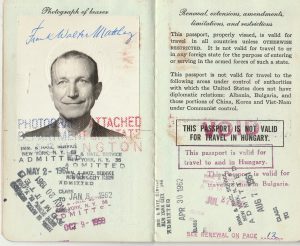
Frank Matthay in his passport issued 1959. Matthay was the leader of Parker exports from 1928 through 1966.
Who was her father? No. Not George or Kenneth Parker. Her father was the unassuming sounding Frank Matthay…the man responsible for making Parker a global brand!
Her story is equally captivating as her father’s. Camy came along late in Frank’s life. And, unfortunately, he died of early-onset Alzheimer’s in the mid-1970s when she was a teen. His memories were robbed of him by the disease, just as she was coming of age and really interested in getting to know her father as a person more than just Dad. Life moves quickly in one’s teens and twenties, and a little later in adulthood Camy decided to reconnect with her late father when she uncovered a treasure trove of boxes filled with his papers, passports, photos and other personal effects.
Frank, as it turns out, lived the adventure of a lifetime. Not only did he live well at a time when most of the world lived in crushing poverty, he saw the world before it lost much of its mystery. He met presidents and Nazis—generals and actual Amazonian headhunters. He helped give birth to the Parker Vacumatic, 51, 61 and 75!
Thankfully, Camy has shared her discoveries with me and is happy to share them with you, too. The following is my summary of her father’s biography with her full approval.
Frank Matthay was born May 10, 1904, in Beyenberg, Germany. Too young to fight in World War I, he was a talented student in what now would be considered a college-prep high school. Here he specialized in studying the classics, including the languages Latin, Greek, Hebrew, French and his native German. Along the line, he also picked up English.
At the tender age of 19, he immigrated to the United States in 1923. He was sponsored by his uncle. Germany, at the time, was struggling desperately with the national economic collapse of post-WWI reparations and more. He moved to Chicago, where he was supposed to work in his uncle’s grocery store. However, it seems he never worked for his uncle, taking a job initially as a soda jerk and taking night classes at a YMCA.
It is unclear when and where he mastered English, as well as Spanish, Portuguese and some Mandarin Chinese. Yet, his early training in the German school system likely made it very easy for him to learn any other language put in front of him.
Also unclear is how he joined the Parker Pen Company in January 1928, at the age of 23. His mastery of languages was what got him a job in the export department, and he was soon working closely with George and Kenneth Parker.
By all accounts, Frank was the life of any party with a natural gift of gab and always armed with a joke and amusing stories. He was tall and lean with a broad, easy smile and a glimmer of mirth in his eyes, plus he had a meticulously Teutonic attention to detail. All important traits for setting up a global distribution and sales network in Central America, South America, Europe, Asia and South Africa!
After a year with the company, Frank was sent on his first assignment to Cuba on the two-year-old airline known as PanAmerican. His career would actually parallel the rise of PanAm. He rode on every glamorous (and not-so-glamorous) float plane they had including the very early Sikorsky S-38, Consolidated Commodore and the extremely lux Sikorsky S-40 “Caribbean Clipper,” which was the first of PanAm’s famous “Clipper” airliners.
On the success of his Cuba trip, in 1930 he was sent to Cuba, Haiti, the Dominican Republic, Puerto Rico, Germany, Denmark, Sweden, Switzerland, Italy, France, Mexico and Cuba, once again. During his trip to Europe on the SS Bremen, he witnessed one of the first, if not the first, aircraft launched from a ship at sea. It was a mail plane launched from a catapult to speed the delivery of the mail the ship was carrying. In 1931, he spent 6 months “on the road” building Parker’s network in Australia and Southeast Asia!
An avid photographer, Frank took pictures of all of his travels. He has images of President Herbert Hoover’s 2-car motorcade in Port au Prince, Haiti. He loved exploring volcanos. On one of his trips to Peru or Ecuador he met and photographed a tribe of headhunters. He even bought a shrunken head from them for $25 (about $330 in our current money). The images look as if they could have been in National Geographic.
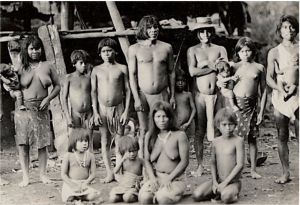
Frank took this photo of a tribe of headhunters in Peru or Ecuador. He bought a shrunken head from them for $25.
If you remember my stories about Kenneth Parker befriending Gen. Dwight Eisenhower in the Philippines, Frank was with them!
Fans of the Parker 51 will love knowing that Frank was the architect of the 1939 and ’40 release of the preliminary Parker 51s in South America and the Caribbean! His itinerary in 1939 was packed with extended trips south of the border. His itinerary on PanAmerican Airlines alone cost nearly $27,000 in today’s money. That doesn’t count his hotels, meals, etc. Yet, it also laid the ground work for the sale of tens of millions of Parker 51s both abroad and at home.

Here is Frank’s copy of the PanAm route map from 1931. Odds are really good that he flew every leg of that route.
Financially speaking, Frank was very well paid for his efforts. At the end of the Great Depression in 1939, he was making $5,000 a year. That is just shy of $100,000 a year in today’s money. And that doesn’t count for his luxury travel and adventures paid for by the company. According to records from Janesville that Camy found, he was making more than local doctors. Parker’s famous nib grinders of 1939 made $2,400 a year. A typist at Parker would make $1,000 a year. (Other cool details she uncovered.)
Frank’s passports are works of art, colorfully illustrated with visas to scores of nations. More impressive than the stamps of many colors are the notes from customs officials. Chilling are the notes by Nazis and Italian fascists telling him where he can and cannot go. It also seemed to him at times that the Nazis had him under surveillance. As a former German citizen who became a naturalized American, he was suspicious to them.
As it turns out, they had good reasons to suspect him. He was very anti-fascism. After the outbreak of World War II, he worked with friends and family in Belgium to funnel money to the resistance fighting Nazi-occupation.
His post-war years were just as busy, as he rebuilt Parker’s global networks from the rubble of Europe’s and much of Asia’s destruction.
Unfortunately, a life of travel and corporate empire building was rough at home. His first marriage, in which he had 3 children, ended in divorce. Later in life he remarried and had three more children, including Camy. Yet, that was difficult, too. He traveled around the world so much, a very, very young Camy thought he was one of America’s first astronauts for a little while.
In 1960, Parker opened a sales office in Paris, and Frank and his family were moved there to run the office until 1962.
By the mid-1960s, Frank’s memory started to fail. Very little was known about neurological diseases such as Alzheimers back then, and doctors actually thought his medical problems stemmed from diseases he might have picked up on his travels or from eating exotic native foods, such as, apparently, a still beating snake heart in Vietnam.
Frank retired as a vice president at Parker in 1966, after 38 years of dedicated service. He continued his hobby of collecting stamps and learning Russian and Sandskrit until his Alzheimers made it impossible. He passed away in 1974.
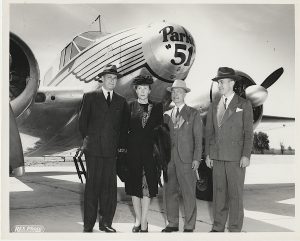
Frank is on the far right posing with the famed Parker 51 airplane. Among his many other hobbies, Frank was a licensed pilot, though I do not know if he flew the “51.”
Honestly, there are so many more adventures in Frank’s life, but I just couldn’t fit them all into this post without simply writing a book. I am so thankful for Camy’s reaching out to me and sharing her stories and research. I hope you enjoy learning a little more about Parker’s international growth and its star salesman and leader.
Have a wonderful Thanksgiving and holiday season. No matter how bad this pandemic gets, remember we are going to get through it. A vaccine is on its way. And one day, this pandemic will be nothing more than a bad memory. Thank you for visiting and supporting ThePenMarket.com. We can’t do it without you, and we are so grateful for you. Stay strong and keep writing.
Decameron 2020: The Pickerel Witch
Ilke and Streusel were walking through Germany’s dark, primeval Black Forest. They had been lost and wandering for days.
“Ilke,” her little brother called. “I’m hungry. Why did our evil step-mother send us on this horrible quest to find dingleberries in the forest?”
“I don’t know,” she replied. “But even if we find this dingleberry bush, I do not think we can find our way back to our loving-but-easily-duped father and have a dingleberry pie.”
They trudged on, weak and trembling.
“Remember our friends, Hansel and Gretel?” Streusel asked.
“Of course.”
“Well, just last week I heard that they found a cabin made of candy,” he said. “Maybe it is still here somewhere close to us.”
“I hope not,” Ilke shivered. “I heard they met a witch who tried to eat them.”
“Yeah, but they pushed her into an oven and killed her. That means there should be plenty of fresh candy waiting for us.”
“I think we’d be better off avoiding witches.”
Eventually they came to a swampy clearing. They rested their weary little bottoms on a log.
“I’m so hungry,” Streusel exclaimed. “I could eat a frog.”
Just like that a splotchy, warty Pickerel frog hopped up between them on the log.
With the last of his strength, Streusel caught the frog and held it gently in his hands as he contemplated eating it raw.
“Don’t hurt it,” Ilke commanded. “It never did anything to you. You have no right to take its life.”
Streusel cried with guilt for ever thinking of killing a living creature, and he cried because he was hungry. He carefully set the plump little amphibian down.
It looked at him and ribbeted, “Thanks.” Next there was a flash and poof.
The children screamed as a beautiful woman with thick, shoulder-length blonde hair appeared wearing a long, black dress, black hobnail boots and a wide-brimmed black pointy hat.
She produced a compact from her black-satin dress and powdered her nose. Then she gave a toss of her golden locks, just for effect before closing her compact.
“Hi there,” she greeted the children. “My name is Madison, but you can call me Maddie.”
The children looked at her and trembled in terror.
“Oh, you little lambs must be starving,” she said and handed each child a peanut butter and jelly sandwich with the crusts cut off, just they way they liked.
“Our step-mother says never to take food from strangers,” Ilke declared.
In a sweet and sardonic voice, Maddie asked, “The same step-mother who intentionally left you in the forest to die so she could have lots of sex with your dim-witted father and raise her spawn in your place?”
“Ohhhh,” the kids sighed, thought about it and devoured their sandwiches.
Feeling better, Streusel asked, “Are you going to eat us now?”
Madison laughed with impish delight.
“No, Sweetie. That was Hildegarde, who Hansel and Gretel did in so nicely. She was old skool. Very conservative and traditional,” Maddie explained. “I’m with the more progressive Witchs’ Welfare League. We love good little girls and boys and think it is unfair to prey on them when they are already such easy and undeserving targets.”
The siblings nodded appreciatively.
“So what are you going to do with us?” Ilke asked apprehensively.
“Nothing, dear child,” Madison said. “The real question is, ‘What are you going to do to help me?’”
“What do you mean?” Ilke asked.
Madison pinched Ilke’s ribs and said, “Well, it feels to me as if you haven’t had any meat in ages.”
“No, we haven’t,” Streusel told her.
“How about you guys help me chop up your step-mother and eat her for dinner, and then you can live happily ever after with your loving father.”
“Yay!” cheered the kids, as they clasped Maddie’s hands, hopped off the log and skipped all the way back home to cannibalize their most-deserving, wicked step-mother.
T
H
END
Decameron 2020: Halloween Movie Night

Autumn is our favorite time of year. Even if you can’t party or trick ‘r treat this Halloween, you can still curl up with some good horror movies.
Pandemic Halloween totally sucks! Halloween is easily one of my favorite holidays. It captures all of the romance of autumn, along with all of the primal frights of life and death. Plus, there’s candy!
Worse, yet, for me is that this is my very first Halloween in New England…the primeval home of All Hallow’s Eve with its lore filled with witches, warlocks, devils and other medieval horrors imported from Europe.
So what do we do now that most reasonable people have called off trick ‘r treating to help protect the lives of our little ghouls and gobblins?
My top choice is turning out all of the lights, lighting a bajillion candles and reading Washington Irving’s “The Legend of Sleepy Hollow.” (Doing this around a fire pit is a good alternative.)
Yet, my second choice is diving into great horror movies. Pop some corn, grab a couple bags of your favorite candies and dive into spooky cinema. Everybody has their favorite, of course. And I firmly believe all kids should be exposed to the joys of the early Universal monster movies, such as “Dracula,” “Frankenstein,” “The Mummy” and “The Wolf-Man.” You can never go wrong with “The Shining,” but, my goal with these movie nights is to avoid the usual go-to films. It is time to delve into great movies you might not be as familiar with.
Horror movies fall into two groups for me. There are the genuinely scary horror films, and then there are the campy horror films. I grew up in a horror movie household. My mom loves campy horror, and my dad loves the movies that will keep you up all night for a week. I got to see them all. And it is funny to me how much movies changed for me as I got older. I was genuinely terrified of the campy horror films as a little kid, but now I laugh at them as an adult.
The key to really enjoying any horror movie is to suspend all disbelief and fall into its world for about 90 minutes. With that said, let’s dive in.
THE BLOB (1958): In Steve McQueen’s first movie role, a meteor crashes to earth near a small town. Teenagers discover the space rock with an old guy. The rock splits open to reveal a small gooey blob that begins eating the old man alive! Rushing him to the doctor, the blob goes on a ravenous rampage, oozing under doors, through vents and anywhere it wants. Is there no way for these good-hearted teens to “extinguish” its hunger? True story: I watched this for the first time when I was about 9 and lived in terror of the film for another 15 years or so. When it came on TV in my 20s, while I was visiting my folks, I tried to get out of watching it with them. “We think it might be a little different than you remembered it at age 9.” Okay, I watched it again, and I laughed at myself and the movie for the rest of the night.
THE TINGLER (1959): Vincent Price plays a scientist who discovers that each of us has a little creature living on our spines called a tingler. It feeds on fear and can kill you by crushing your spine if you don’t scream to release your fear. When he successfully captures a living tingler and it gets loose…well, all hell breaks loose. This was director William Castles’ classic B-movie where he rigged seats in movie theaters with buzzers to randomly scare the audience members. I don’t think this one ever scared me, but that doesn’t mean I haven’t loved it for all of my life.
INVASION OF THE BODY SNATCHERS (1956): Mysterious, human-sized pea pods start showing up at people’s homes. And as people try to make sense of them, the pods create a human clone of the person it was delivered to. Not sure what to make of these clones, the humans are reluctant to do anything about them, but the clones have no compunction about killing their humans and taking over their lives. A fun psychological thriller that is undoubtedly campy at times, but it can give you the creeps if you really let yourself become one with the film.
WAR OF THE WORLDS (1953): H.G. Wells’ classic sci-fi horror story comes to life in amazing Technicolor with this blockbuster. The world’s best special effects were employed for this movie when it first came out. Sure, they look a little hokey now, but I still love the terror imposed by the seemingly unstoppable aliens. The biggest laughs come not from the effects but the blatant sexism and condescending patriarchal nature of the leading men and scientists.
THE CHANGELING (1980): George C. Scott plays a man struggling with the loss of his wife and daughter in a tragic car wreck. Moving to a new town for a change of scene, he rents an old mansion that is already inhabited. To this day, I will contend that this is the most frightening ghost story ever filmed. I love it! I’ve seen it a dozen times, and it still raises the hairs on the back of my neck.
Decameron 2020: Big Bad Ed
Big Bad Ed
By Art Cerf
Ed Brevington was a big man, a hard man, a tough and loud man.
He spent his days in backbreaking labor as a roofer. He spent his nights in bars, looking for anyone who would take him on. Few did and always to their regret.
Then came the pandemic and Ed proclaimed he wouldn’t be wearing a mask. “Hell,” he’d say, “If the President won’t wear one, why should I?”
And he would march maskless into stores, even those that said “No Mask, No Service. Few were bold enough to challenge him. He’d grab what he wanted and then throw money down on the counter and stalk out.
One day he woke with a headache…just a hangover he thought. But on the job, he started having trouble breathing. And his temperature shot up.
Reluctantly, he went to the hospital where he was immediately diagnosed with Covid and slapped into isolation. He spent four long weeks there and when they finally sent him home, he was as weak as a newborn lamb. Doctors told him to rest up and in a few weeks, he’d likely be back to normal.
A few weeks turned into a few months. He had no appetite and lost 50 of his 240 pounds. It was an effort to get out of bed to pee and shower. Then he’d need another nap.
Finally, he returned to the doctors who ran a series of tests on him. One proclaimed, “The virus not only damaged your lungs but your heart as well. You’ll never to able to return to hard labor but there are other, less strenuous things you could do…cashier, phone sales, greeter. You still could lead a full life.”
That life would last about six hours. He went home, collapsed for a nap and when he awoke, he walked up to his bedroom, removed a pistol from his bedside table and pressed it to his temple.
Ed Bevington…damned if he would wear a mask and damned because he didn’t.
Decameron 2020: Death and Mrs. Brock
by Art Cerf
Matilda Brock, all of 90, sat in her nursing home room, enjoying the sunbeam coming through the window, as winter reluctantly gave way to spring.”
Suddenly at the door, hooded death appeared.
“Where the hell have you been?” screamed Mrs B. “I’ve waited for you the past ten years in this pit. I’ve seen two roommates die and other slip into senility, but would you come and rescue me? No!”
Death stepped back a moment. He had heard people scream at his arrival, cry or barter for more time. But no one…no one had ever dared to scream at him over the centuries.
He asked her why.
“All my life,” Matilda said, “I was taught to be silent and submissive…first by my braying jackass of a father and then by my bullying and pompous husband. When he died 30 years ago, I thought finally I’m free and threw myself into community service. But soon, I became everyone’s mule.
“The church could use more flowers. Please take care of it Mildred.”
Or “Who should organize this year’s benefit for the children. Mildred can do it since she has time on her hands.”
“By the time I was 80, my son, Otis, told me I could no longer live alone and since I had given him power of attorney, he sold my home and put me in this place with indifferent food, sloppy nurses aides and fat administrators. There’s only one TV. The women watch it all day for those stupid ladies talk shows, and the men take over at night for either sports or right-wing commentators. My favorite granddaughter, Bess, used to bring me books from the library…murder mysteries were my favorite as I’d plot how to dispose of various folks around me. But then my vision started to go and I could no longer read.”
Death looked at her and in the blink of an eye, transformed into a handsome, well-dressed young man. He took her by the arm and led her out into the hallway.
“Hey, where are you two going,” one aide shouted.
“Out to lunch with my grandson,” Matilda answered.
“So where do you want to go?” asked Death.
“Some place Mexican with some hot and spicy food.”
And so they went and had a delicious lunch.
From there, they were ushered to Bess’ home. Matilda arrived alone and asked to see her new, six-week-old great, great granddaughter.
Bess was delighted to see her, if not uncertain how she arrived. She brought the baby to Matilda and told her, “We named her Maddy, after you.”
Matilda held the baby like she was gold and tears came to her eyes. Moments later, she said she had to go, she had a cab waiting.
After hugs and kisses, Matilda entered a cab. As it drove away, Bess could have sworn the driver was wearing a black hood.
Matilda died that night, as did 13 other residents of the nursing home. Authorities blamed Covid but in truth, Matilda had died of happiness.
(Editor’s note) Death wants it made clear that this was a one-time only exception.


 Shopping Cart
Shopping Cart



